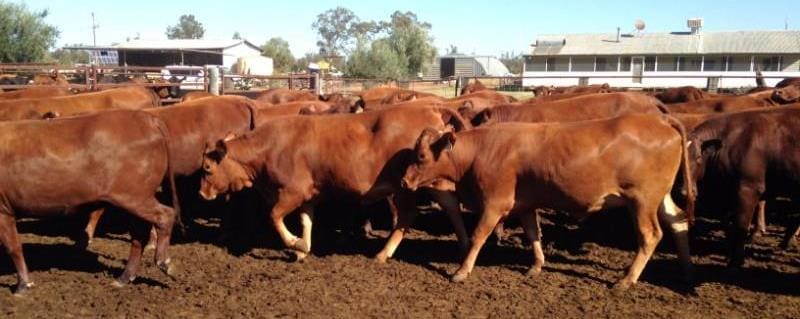
Belmont Red cattle are often associated with smooth bones
During the spring bull selling season, a lasting image from each sale is one of the producers with catalog details in hand checking the bulls in the pen.
For many, this is the final stage of selection, physical observations for bulls that offer the best genetic potential for improvement in their herds.
For others, the inspection is the beginning of their selection process. Often the breeders process works on finding bulls they like the look of and then seeing if the genetics match their needs.
There is risk in this approach. The danger lies in the tendency to buy bulls that are visually appealing, but genetically not at all suited to the desired direction of the business. Often that attractive bull can set a program back several years.
In both approaches, the selection decisions are never straightforward and only one of the two cases should be considered. The challenge all producers face is finding the combination of a bull’s physical fitness to fit into a breeding herd and produce progeny that will meet a herd’s long-term production goals.
Increasing accuracy of genetic information, the result of investment in research and development in areas such as genomics, as well as extensive data collection in research and commercial herds, has made a significant difference in producer selection decisions.
Different “schools of thought”.
However, despite these advances, there are still some schools of thought that encourage selection to be based on single traits represented in the phenotype. Most of these recommendations are based on anecdotal evidence or unproven theories.
Unfortunately, many of these theories are popular among manufacturers because of the convincing way they present them. Or because it’s a simple approach, and simple is often easier for people who struggle with complexity. However, simpler does not always mean that the process works. And anecdotal or unproven methods are just as dangerous.
One of the biggest dangers with anecdotal or traditional approaches is that they are irrelevant to current practice or knowledge.
Beef markets and the industry as a whole have evolved rapidly over the past two decades. Selection based on traits that are not relevant to modern production systems and secondly justifying these traits based on poor correlation with production leads to the production of cows that are less likely to achieve meaningful production goals.
smooth bone, earwax and adrenal hair ring
Examples of these risks can be found in promoting cattle selection on physical traits such as bone smoothness, earwax, and adrenal hair rotation.
These are all the physical characteristics observed in cows. In some cases, there is a correlation between these characteristics and the production results that proponents of this form of selection claim.
All three, along with a fatty backbone (said to be an indicator of hormonal activity and palatability) have recently been hotly debated through social media threads focused on beef genetics.
Smooth bone is associated with tenderness in some muscles, and at least in earlier times, with better carcass performance.
However, it is another matter to find scientifically verified data that can prove that all muscle tenderness is related to bone smoothness.
In comparison, the science underlying MSA is well-researched, well-proven, and applicable to production systems across the country and indeed internationally.
For producers who wish to breed cattle that are more likely to meet consumer expectations for tenderness, genetic traits such as marbling. Flight speed, growth speed are all infinitely more valuable in selection than visual observation of bone shape.
Another equally poor feature is considering selection based on the level of earwax produced by an animal. Proponents of this trait claim that the level of earwax indicates the fat content of the milk and is therefore likely to produce calves that grow faster and have higher weaning weights. Again, there is little or no scientific evidence for such a relationship.
The primary function of earwax is to protect the ear canal by trapping dirt, dust and microorganisms, thus preventing infections and maintaining ear health. While there are traits in dairy selection including milk production and fat content, these traits are based on genetic data and information.
Adrenal hair ring
The third physical feature is the location of the adrenal hair ring on the animal’s spine. Hair rings, technically known as Trichoglyps, have been the source of much interest and research.
American zoologist Dr. Temple Grandin And others have looked at relationships between hair turning and mood. However, visual selectors who support consideration of the adrenal gland argue that the location along the animal’s spine indicates hormonal function and, by extension, fertility.
Again, there is no evidence to suggest that the location of this hair ring has anything to do with hormonal response or the ability to improve herd fertility.
Genetic selection can be used to improve fertility, however, as a trait of low heritability, environmental management is also necessary to achieve improved fertility rates.
Finally, manufacturers should be careful when making recommendations that encourage a simplistic approach based on one or two attributes and possible links to production outcomes.
Almost all products are the result of several genetic combinations. As tempting as it is, sometimes the simple approach is avoided if the ultimate goal is to produce cattle capable of meeting current industry production goals.
 Alastair Rayner is General Manager of Development and Operations with Cibo Labs and Director of RaynerAg. Alastair has over 28 years of experience advising beef and pasture producers across Australia. He can be contacted here or through his website www.raynerag.com.au
Alastair Rayner is General Manager of Development and Operations with Cibo Labs and Director of RaynerAg. Alastair has over 28 years of experience advising beef and pasture producers across Australia. He can be contacted here or through his website www.raynerag.com.au
#Genetics #Weekly #Review #markers #valuable #selecting #production #traits #Central #Beef